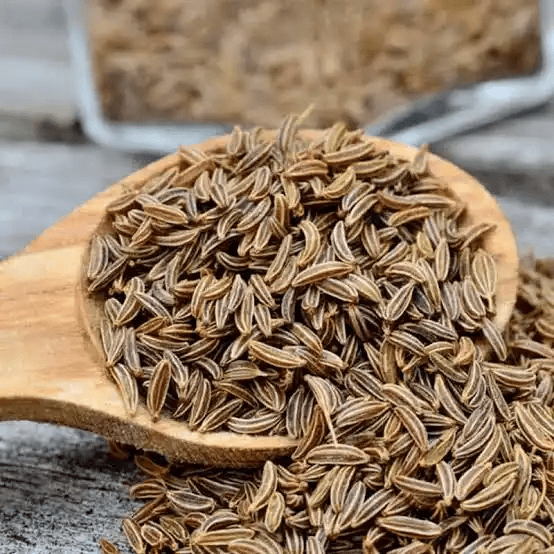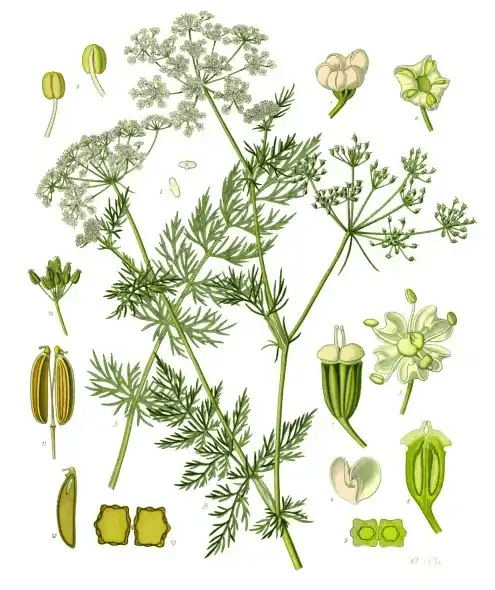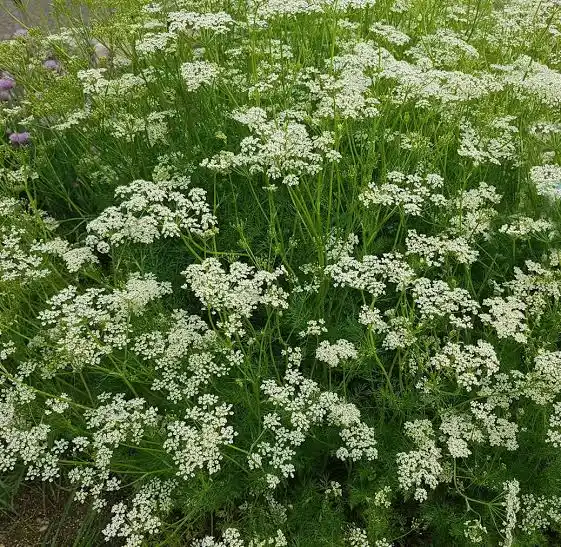Caraway, scientifically known as Carum carvi, is a versatile and aromatic herb that has been valued for its culinary and medicinal properties for centuries.
This biennial plant belongs to the Apiaceae family and is native to Western Asia, Europe, and Northern Africa. Renowned for its distinctive fragrance and warm, earthy flavor, caraway has carved a niche for itself in various culinary traditions and herbal remedies.
The caraway plant typically grows to a height of about 30 to 80 centimeters and boasts finely divided feathery leaves. During its first year, the plant forms a rosette of leaves, and in the second year, it produces a flowering stem. The small white or pink flowers are arranged in umbels, creating a delicate and aesthetically pleasing display.
Caraway seeds, the most coveted part of the plant, develop in elongated fruits, commonly referred to as seed-like fruits or schizocarps. These seeds are the primary source of the herb’s intense flavor and aroma.
One of the most notable characteristics of caraway is its strong and distinct aroma, which can be described as a blend of anise and fennel with a hint of citrus.
This unique scent is attributed to the presence of essential oils, particularly carvone and limonene, which contribute not only to the herb’s fragrance but also to its therapeutic properties.
In the culinary realm, caraway seeds are a popular spice, particularly in European cuisines. They are a key ingredient in traditional dishes such as rye bread, sauerkraut, and various savory stews.
The warm, slightly sweet taste of caraway adds depth and complexity to a wide range of recipes, making it a staple in many kitchens. Additionally, the seeds can be ground to enhance their flavor and incorporated into spice blends for seasoning meats, vegetables, and soups.
Beyond its culinary applications, caraway has a rich history of medicinal use. The herb has been employed for its digestive properties, helping to alleviate indigestion, bloating, and flatulence.
Caraway’s essential oils are believed to have carminative effects, soothing the digestive tract and promoting the expulsion of gas. Additionally, the herb has been utilized in traditional medicine for its antimicrobial properties and its potential to relieve respiratory issues.
Caraway’s versatility extends beyond the kitchen and medicine cabinet. It has found a place in the world of beverages, as its seeds are occasionally used to flavor liqueurs and spirits.
Furthermore, the herb’s aromatic qualities have made it a popular choice for potpourris and sachets, providing a natural and pleasant fragrance to living spaces.
Cultivating caraway is a relatively straightforward process, and it adapts well to various climates. It prefers well-drained soil and thrives in full sun to partial shade. The plant is generally low-maintenance, making it accessible to both experienced gardeners and those new to herb cultivation.
Caraway, with its aromatic seeds and distinctive flavor profile, holds a significant place in both culinary and medicinal traditions. Whether enhancing the taste of a hearty stew or providing relief from digestive discomfort, Carum carvi continues to captivate with its versatility and timeless appeal.
The Botanical Description of Caraway
1. Appearance: Caraway features finely divided feathery leaves that are delicate and fern-like in appearance. The plant reaches a height of about 30 to 80 centimeters, with slender stems that bear clusters of small white or pink flowers.
2. Leaves: The leaves of the caraway plant are pinnately compound, meaning they consist of multiple leaflets arranged on either side of a common stalk. These leaves impart a lacy and airy appearance to the plant.
3. Flowers: Caraway produces umbrella-like flower clusters, typical of plants in the Apiaceae family. The flowers are small and numerous, forming dense inflorescences at the tips of the stems.
4. Fruits: The fruits of the caraway plant are distinctive and play a central role in its culinary use. These fruits, commonly referred to as caraway seeds, are elongated, curved, and brown in color. Each fruit contains a single seed.
5. Roots: Caraway has a taproot system, with the primary taproot being fleshy and elongated. The root system provides stability to the plant and allows it to access nutrients from the soil.
6. Aroma: One of the defining characteristics of caraway is its strong and distinctive aroma. The seeds, in particular, emit a warm and slightly sweet fragrance with hints of citrus.
7. Growth Cycle: Caraway is a biennial plant, meaning it completes its life cycle in two years. During the first year, it forms a rosette of leaves, and in the second year, it produces flowers and seeds before completing its life cycle.
8. Culinary Uses: While the entire caraway plant is edible, it is primarily the seeds that are used in cooking. Caraway seeds have a warm, earthy flavor with a slight anise undertone, making them a popular spice in various cuisines worldwide.
The Geographic Distribution of Caraway
1. Native Regions: The historical origins of caraway trace back to regions encompassing present-day Western Asia, including parts of Turkey and Iran, as well as Europe and North Africa.
2. Cultivation Worldwide: Due to its culinary and medicinal importance, caraway has been cultivated and introduced to numerous regions globally. It is now grown in countries such as Germany, the Netherlands, Russia, and the United States.
3. Adaptability: Caraway is well-suited to temperate climates with well-drained soil. It thrives in regions with cool to moderate temperatures, making it a suitable crop for countries with such climates.
4. Commercial Production: Major producers of caraway include European countries like Germany, the Netherlands, and Poland. Additionally, the United States, particularly North Dakota, is a significant contributor to global caraway production.
5. Naturalization: Caraway has naturalized in various regions outside its native range. The plant’s adaptability has allowed it to establish itself in areas with similar climatic conditions.
6. Culinary Integration: The widespread use of caraway in global cuisines has contributed to its popularity and cultivation in diverse regions. It is often integrated into traditional dishes, providing a distinct and aromatic flavor.
7. Home Gardens: Caraway is also cultivated in home gardens, allowing individuals to enjoy the fresh leaves, seeds, and the plant’s ornamental value.
The Chemical Composition Of Caraway
1. Essential Oils: The essential oil of caraway seeds is a major component, constituting various volatile compounds. Carvone and limonene are two primary components responsible for the characteristic aroma.
2. Carvone: Carvone is a major monoterpene present in caraway and is responsible for its distinct flavor. It imparts a warm, sweet, and slightly peppery taste to the seeds.
3. Limonene: Limonene is another significant monoterpene found in caraway, contributing to the citrusy undertones in both aroma and taste.
4. Pinene: Caraway seeds may contain pinene, a bicyclic monoterpene, adding complexity to its aromatic profile.
5. Flavonoids: Caraway contains flavonoids, which are antioxidant compounds known for their potential health benefits. These include quercetin, kaempferol, and luteolin.
6. Fatty Acids: The seeds of caraway contain fatty acids, including oleic acid and linoleic acid. These fatty acids contribute to the nutritional value of caraway.
7. Minerals: Caraway seeds are a source of essential minerals, including iron, manganese, and magnesium. These minerals play a role in various physiological functions and contribute to the overall nutritional content of caraway.
8. Dietary Fiber: Caraway seeds contain dietary fiber, which aids in digestion and helps maintain a healthy digestive system. The fiber content contributes to a feeling of fullness and can assist in weight management.
9. Proteins: Caraway seeds contain proteins, albeit in smaller quantities. Proteins are essential for various bodily functions, including the repair and maintenance of tissues.
10. Carbohydrates: Caraway seeds also provide carbohydrates, serving as a source of energy. The carbohydrates in caraway are complemented by the presence of dietary fiber.
11. Antioxidants: The combination of flavonoids, essential oils, and other compounds in caraway seeds contributes to its antioxidant properties. Antioxidants help neutralize free radicals, potentially reducing oxidative stress in the body.
12. Phytochemicals: Caraway is rich in phytochemicals, which are bioactive compounds derived from plants. These phytochemicals may have potential health benefits, including anti-inflammatory and antimicrobial properties.
Read Also: 15 Medicinal Health Benefits Of Horseradish (Armoracia rusticana)
The Medicinal Health Benefits Of Caraway (Carum carvi)

1. Digestive Aid: Caraway is known for alleviating digestive issues, reducing bloating, indigestion, and gas due to its essential oils like carvone.
2. Anti-inflammatory Properties: Compounds in caraway, like flavonoids, exhibit anti-inflammatory effects, potentially aiding in conditions like arthritis.
3. Respiratory Health Support: Its essential oils, such as limonene, may clear the respiratory tract, beneficial for bronchitis or asthma.
4. Antioxidant Action: Caraway’s antioxidants, including flavonoids, neutralize free radicals, combating oxidative stress-related issues.
5. Menstrual Symptom Relief: Traditionally used to ease menstrual discomfort, its anti-spasmodic properties can reduce cramps.
6. Weight Management Support: Dietary fiber in caraway seeds contributes to a feeling of fullness, aiding in weight management.
7. Antibacterial and Antifungal Effects: Caraway exhibits antibacterial and antifungal properties, aiding in preventing infections.
The Methods of Usage to Achieve the Provided Health Benefits Of Caraway (Carum carvi)
1. Culinary Incorporation: Add caraway seeds to soups, stews, or salads to enjoy its benefits.
2. Caraway Tea: Steep crushed caraway seeds in hot water to promote digestion and respiratory health.
3. Essential Oil Application: Dilute caraway essential oil with a carrier oil for massages to alleviate tension.
4. Herbal Infusions: Combine caraway with other herbs for a variety of health benefits.
5. Dietary Supplements: Capsules or extracts under professional guidance for controlled consumption.
The Side Effects Of Using Caraway Medicinal Plant
1. Allergic Reactions: Skin rashes, itching, or respiratory symptoms may occur in some allergic individuals.
2. Gastrointestinal Issues: Excessive consumption might lead to nausea or stomach upset in rare cases.
3. Interaction with Medications: Caraway supplements may interact with certain medications.
4. Pregnancy and Breastfeeding: Safety during these times is not well-established; consult a doctor.
5. Blood Sugar Effects: Monitor blood sugar levels, especially for diabetic individuals or those on medications.
6. Surgery: Inform healthcare providers about caraway usage if scheduled for surgery, as it may interact with anesthesia.
Read Also: The Economic Significance of Farm and Land
The Scientific Research and Studies of Caraway

1. Antimicrobial Properties: Numerous studies have explored caraway’s antimicrobial effects, showcasing its potential against various bacteria and fungi.
2. Gastrointestinal Health: Research suggests that caraway may promote gastrointestinal well-being by reducing symptoms of indigestion and enhancing digestive functions.
3. Anti-inflammatory Effects: Scientific investigations have indicated caraway’s anti-inflammatory properties, attributing it to certain compounds like flavonoids.
4. Antioxidant Activity: Studies highlight caraway’s antioxidant capabilities, contributing to its potential in reducing oxidative stress in the body.
5. Potential Anticancer Properties: Some preclinical studies propose that caraway might have anticancer effects, though further research is needed for conclusive evidence.
6. Effects on Blood Sugar Levels: Scientific research has explored the impact of caraway on blood sugar levels, suggesting potential benefits for individuals with diabetes.
7. Liver Protective Effects: Research indicates that caraway may have hepatoprotective properties, supporting liver health.
8. Anti-Anxiety Properties: Certain studies propose that caraway might have anxiolytic effects, potentially reducing anxiety levels.
The Safety Precautions and Recommendations In Using Caraway Medicinal Plant
1. Allergic Sensitivity: Individuals with known allergies to caraway or similar plants should exercise caution and conduct a patch test before widespread use.
2. Moderation in Consumption: While caraway is generally safe, excessive intake may lead to adverse effects. Moderation is key.
3. Pregnancy and Breastfeeding: Pregnant or breastfeeding individuals should consult healthcare professionals before incorporating caraway into their routines.
4. Interaction with Medications: Caraway supplements may interact with certain medications, especially those affecting blood sugar levels. Consult with a healthcare provider if on medication.
5. Digestive Sensitivity: Some individuals may experience gastrointestinal discomfort with high doses of caraway. Adjust consumption accordingly.
6. Surgery Precaution: If scheduled for surgery, inform healthcare providers about caraway usage, as it may interact with anesthesia.
FAQs About Caraway Medicinal Plant
1. Can Caraway Seeds Be Consumed During Pregnancy?
It’s advisable to consult a healthcare professional before consuming caraway during pregnancy due to limited safety data.
2. Are There Any Known Drug Interactions with Caraway?
Caraway may interact with medications affecting blood sugar levels; consult with a healthcare provider if on such medications.
3. What is the Recommended Daily Intake of Caraway Seeds?
While there’s no established daily intake, moderation is recommended. Daily consumption should align with culinary use or as directed by a healthcare professional.
4. Can Caraway Essential Oil be Applied Topically?
Yes, but it should be diluted with a carrier oil to avoid skin irritation. Conduct a patch test before extensive use.
5. Is Caraway Safe for Children?
While caraway is generally safe, it’s advisable to consult with a pediatrician before giving it to children, especially in concentrated forms.
Read Also: Biomedical Waste Recycling and Reuse Process

